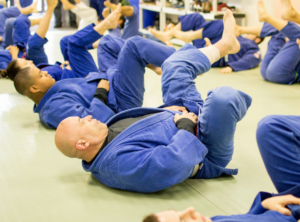Thanks to Ilya K. for this amazing essay. As a deeply committed practitioner at BBJJ, he understands both the challenges that come with learning the art of Jiu-Jitsu and the struggle to “swim against the grain” and absorb the cooperative philosophy of our classroom. His words capture the trickiness of navigating the path as the beginner becomes the intermediate student, and learning the importance of the culture of sustainability. Hope you enjoy reading it!
I believe that it’s not until we reach blue belt that even a mild understanding of Jiu-Jitsu fundamentals sets in. Once we reach this milestone, our training becomes a little easier, facial expressions become softer, and our breathing becomes more controlled. Only after that can we actually begin a real lifelong study of Jiu-Jitsu.
Before this phase, when we can relax and observe what is happening around us, we’re usually doing a poor imitation of what we’ve seen others do, while simultaneously feeding our own egos.
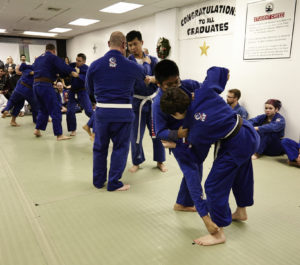 The truth is, contrary to what a beginner might glean from the media depictions of this martial art – physicality, toughness and sometimes near-violence – most Jiu-Jitsu happens in the mind. If you practice already, you know this. If you cannot control your thoughts, intentions, and emotions, your progress will be minuscule, regardless of how much strength you use to dominate or oppress your partner.
The truth is, contrary to what a beginner might glean from the media depictions of this martial art – physicality, toughness and sometimes near-violence – most Jiu-Jitsu happens in the mind. If you practice already, you know this. If you cannot control your thoughts, intentions, and emotions, your progress will be minuscule, regardless of how much strength you use to dominate or oppress your partner.
As white belts, we all enter a school with wonderful intentions of growth and progress, and it is a martial arts school’s responsibility to imbue these aspiring warriors with the right mindset.
The most beautiful aspect is that this mental training is so subtle, that you don’t even know it’s changing you for the better.
In the absence of this guidance, the white belts are left to themselves with nothing to do but imitate what’s in front of them. More often than not, it is the glorified brutality of MMA or the adroit movements of a higher belt. Naturally, one would be infected with a desire to be like them. And that’s where the problems begin.
Just as plants require extra nurturing at the seed stage, the young students must be given more attention than any other belt. It is in their healthy progression that lies the eventual success of any school.
Here’s why…
The purple and brown belts will show up for class, and they will use the scissor sweep and they will do the kimura when the time is right. But on the other side, the white belts generally have no idea what’s going on, so they are left to utilize the only tools they know: passive hostility and force.
No one really wants to roll with a white belt, because they don’t know what they are doing. The reason why they don’t is because no one showed them how. A cycle of self-destructive aggression sets in, which often ends with the white belt dropping out.
Luckily for me, a great mentor and guide has appeared in my life at the right time.
I was fortunate enough to get the necessary guidance at Brooklyn Brazilian Jiu-Jitsu from the founder and owner of the 5 schools in that borough, Gene Dunn. Through a very technical yet gentle approach, Gene Dunn and his staff offer not only the necessary grappling and physical know-how, but – most importantly – they have a set curriculum of mindset training with weekly messages.
The entire idea is based on educating every student properly, so we can each become better human beings through the art of Jiu-Jitsu.
Through this process, I have learned that Jiu-Jitsu is a gentle art, not a way to destroy someone
For example, every class ends with the student creed, during which we affirm our intentions of growth, respect, and discipline. Over time this begins to sediment into our very core, and we have no choice but to “roll” responsibly and consciously. Any other way brings destruction rather than creation. Furthermore, at the end of every class we are reminded of the fundamentals associated with the Jiu-Jitsu black belt lifestyle, whether it is how we eat or how we treat our friends and relatives.
Training under Gene Dunn has had a tremendous impact on my life. I have grown as a man, I’ve become more accountable, more giving, and more aware of the consequences of my words and actions. The most beautiful aspect of training at Brooklyn Brazilian Jiu-Jitsu is that this mental training is so subtle, that you don’t even know it’s changing you for the better. You don’t realize how you’ve grown until you find yourself in a different environment, surrounded by more challenging circumstances.
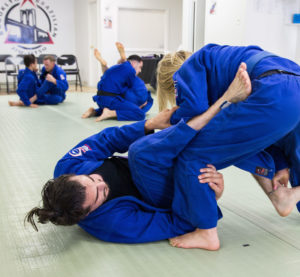 There was a time when I was frantically huffing and puffing, and there was also a time when I would use aggression and speed to attempt anything on the mat, and there was a time when my face would turn red and my teeth would grind in futile exertion. I don’t do that anymore, because I’ve realized it is not the way and creates nothing but distance between myself and my rolling partner.
There was a time when I was frantically huffing and puffing, and there was also a time when I would use aggression and speed to attempt anything on the mat, and there was a time when my face would turn red and my teeth would grind in futile exertion. I don’t do that anymore, because I’ve realized it is not the way and creates nothing but distance between myself and my rolling partner.
The way to this state is not an easy one, and can only be achieved with the proper mindset planted early on. For example, as we understand in class, submissions cannot come before position. That is something that any higher belt doesn’t need to be told, but to a beginning practitioner it would appear as nonsense, because all they want to do is execute that choke they saw online or in the latest MMA fight.
The root of all pain and suffering is ignorance, and it is our job as Jiu-Jitsu practitioners to eradicate this ever-present force from the mat, whatever school we are practicing at.
Furthermore, the concept of mutual respect and growth must be put above all other aspirations for a beginning practitioner. Without these fundamentals all training is a waste of time. It is equivalent to climbing a ladder, and seeing that it was leaned against the wrong wall the entire time only when you are almost at the top.
Through this process, I have learned that Jiu-Jitsu is a gentle art, not a way to destroy someone. We must always be mindful of what we are doing on the mat. Are we there to destroy whomever comes into our space, or are we trying to learn, understand, and help our partners?
The root of all pain and suffering is ignorance, and it is our job as Jiu-Jitsu practitioners to eradicate this ever-present force from the mat, whatever school we are practicing at. It is our job as higher belts to guide the beginners and to have the humility to ask them to relax, to explain the techniques, and to guide them to a higher level of understanding. If we are not willing to do that, then the color of our belt is just an accessory on our gis.
I wish to extend my utmost gratitude to Gene Dunn and to his entire staff for working with me and shaping me into the man that I’ve become. Thank you!
Ilya K. is a blue belt at Brooklyn Brazilian Jiu-Jitsu, and the founder and owner of Aida Shoes.
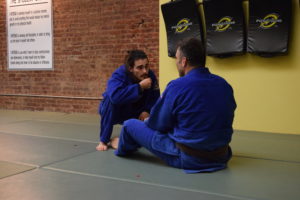






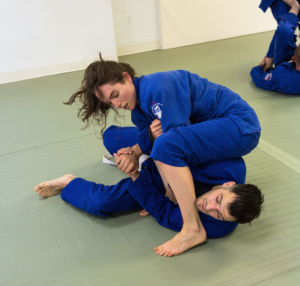 Asking questions is an excellent way to expand your knowledge base in the martial arts classroom…and it’s a great habit to develop if you’re interested in your personal growth off the mat as well.
Asking questions is an excellent way to expand your knowledge base in the martial arts classroom…and it’s a great habit to develop if you’re interested in your personal growth off the mat as well. The truth is, contrary to what a beginner might glean from the media depictions of this martial art – physicality, toughness and sometimes near-violence – most Jiu-Jitsu happens in the mind. If you practice already, you know this. If you cannot control your thoughts, intentions, and emotions, your progress will be minuscule, regardless of how much strength you use to dominate or oppress your partner.
The truth is, contrary to what a beginner might glean from the media depictions of this martial art – physicality, toughness and sometimes near-violence – most Jiu-Jitsu happens in the mind. If you practice already, you know this. If you cannot control your thoughts, intentions, and emotions, your progress will be minuscule, regardless of how much strength you use to dominate or oppress your partner. There was a time when I was frantically huffing and puffing, and there was also a time when I would use aggression and speed to attempt anything on the mat, and there was a time when my face would turn red and my teeth would grind in futile exertion. I don’t do that anymore, because I’ve realized it is not the way and creates nothing but distance between myself and my rolling partner.
There was a time when I was frantically huffing and puffing, and there was also a time when I would use aggression and speed to attempt anything on the mat, and there was a time when my face would turn red and my teeth would grind in futile exertion. I don’t do that anymore, because I’ve realized it is not the way and creates nothing but distance between myself and my rolling partner.